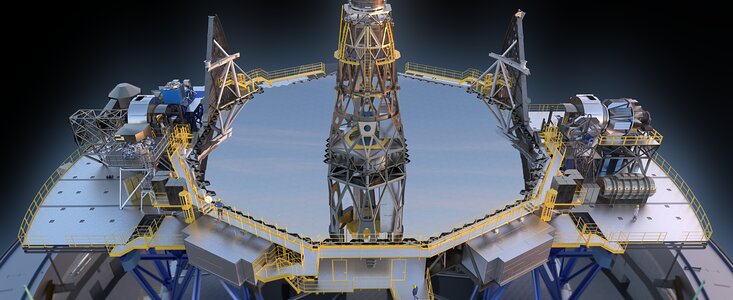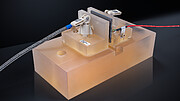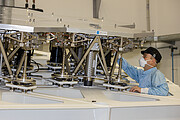Anúncio
Entregues ao ELT do ESO os sensores de borda e atuadores para Astronomia mais precisos de sempre
25 de Outubro de 2024
Após vários anos de trabalho e de construção de milhares de sensores de borda e atuadores de posição, estão finalmente concluídos os últimos conjuntos destas peças de alta tecnologia para o espelho primário do Extremely Large Telescope (ELT) do ESO.
Com um diâmetro de 39 metros, o espelho (M1) do ELT é o maior alguma vez fabricado para um telescópio óptico. Demasiado grande para ser fabricado numa única peça, este espelho é constituído por 798 segmentos individuais. Cada segmento hexagonal terá vários sensores ligados às suas bordas e será montado em três atuadores de posição. Os sensores de borda, cerca de 4500 pares, e os atuadores, cerca de 2400, são essenciais para ajustar com precisão a posição de cada segmento e fazê-los funcionar como se de uma única entidade se tratassem. Para que o espelho tenha uma curvatura perfeita e suave, os sensores de borda medem os potenciais desalinhamentos, que são depois corrigidos pelos atuadores de posição extremamente precisos.
Os sensores de borda do espelho primário do ELT são os mais precisos alguma vez utilizados num telescópio. São capazes de medir a posição relativa dos segmentos com uma precisão de alguns nanómetros. Se um grilo pousasse num canto dum segmento, deslocando-o de um milionésimo de milímetro, os sensores seriam capazes de detectar essa perturbação mínima. Os sensores foram produzidos pelo consórcio FAMES, uma cooperação entre os especialistas em sensores Micro-Epsilon Messtechnik (Alemanha) e Fogale Nanotech (França), criado especificamente para este projeto.
Os atuadores de posição darão apoio aos segmentos, controlando-os ativamente em três direcções (pistão, viragem e inclinação), o que implica a movimentação de pesos consideráveis, uma vez que cada segmento do espelho pesa 250 kg. Concebidos e desenvolvidos pela Physik Instrumente (PI, Alemanha), estes atuadores únicos, que levam a tecnologia aos seus limites, serão capazes de ajustar suavemente a posição dos segmentos com uma precisão de apenas alguns nanómetros.
Uma vez entregues ao ESO, os sensores de borda e os atuadores de posição irão agora ser enviados para o Chile, onde serão integrados nos segmentos do espelho e no telescópio, respetivamente. O ELT encontra-se atualmente em construção no topo do Cerro Armazones, no deserto chileno do Atacama. Quando estiver concluído, esperam-se descobertas únicas e revolucionárias que irão certamente mudar a nossa compreensão do Universo.
Contactos
Bárbara Ferreira
ESO Media Manager
Garching bei München, Alemanha
Tel: +49 89 3200 6670
Email: press@eso.org
Sobre o anúncio
| Id: | ann24017 |
Our use of Cookies
We use cookies that are essential for accessing our websites and using our services. We also use cookies to analyse, measure and improve our websites’ performance, to enable content sharing via social media and to display media content hosted on third-party platforms.
ESO Cookies Policy
The European Organisation for Astronomical Research in the Southern Hemisphere (ESO) is the pre-eminent intergovernmental science and technology organisation in astronomy. It carries out an ambitious programme focused on the design, construction and operation of powerful ground-based observing facilities for astronomy.
This Cookies Policy is intended to provide clarity by outlining the cookies used on the ESO public websites, their functions, the options you have for controlling them, and the ways you can contact us for additional details.
What are cookies?
Cookies are small pieces of data stored on your device by websites you visit. They serve various purposes, such as remembering login credentials and preferences and enhance your browsing experience.
Categories of cookies we use
Essential cookies (always active): These cookies are strictly necessary for the proper functioning of our website. Without these cookies, the website cannot operate correctly, and certain services, such as logging in or accessing secure areas, may not be available; because they are essential for the website’s operation, they cannot be disabled.
Functional Cookies: These cookies enhance your browsing experience by enabling additional features and personalization, such as remembering your preferences and settings. While not strictly necessary for the website to function, they improve usability and convenience; these cookies are only placed if you provide your consent.
Analytics cookies: These cookies collect information about how visitors interact with our website, such as which pages are visited most often and how users navigate the site. This data helps us improve website performance, optimize content, and enhance the user experience; these cookies are only placed if you provide your consent. We use the following analytics cookies.
Matomo Cookies:
This website uses Matomo (formerly Piwik), an open source software which enables the statistical analysis of website visits. Matomo uses cookies (text files) which are saved on your computer and which allow us to analyze how you use our website. The website user information generated by the cookies will only be saved on the servers of our IT Department. We use this information to analyze www.eso.org visits and to prepare reports on website activities. These data will not be disclosed to third parties.
On behalf of ESO, Matomo will use this information for the purpose of evaluating your use of the website, compiling reports on website activity and providing other services relating to website activity and internet usage.
Matomo cookies settings:
Additional Third-party cookies on ESO websites: some of our pages display content from external providers, e.g. YouTube.
Such third-party services are outside of ESO control and may, at any time, change their terms of service, use of cookies, etc.
YouTube: Some videos on the ESO website are embedded from ESO’s official YouTube channel. We have enabled YouTube’s privacy-enhanced mode, meaning that no cookies are set unless the user actively clicks on the video to play it. Additionally, in this mode, YouTube does not store any personally identifiable cookie data for embedded video playbacks. For more details, please refer to YouTube’s embedding videos information page.
Cookies can also be classified based on the following elements.
Regarding the domain, there are:
- First-party cookies, set by the website you are currently visiting. They are stored by the same domain that you are browsing and are used to enhance your experience on that site;
- Third-party cookies, set by a domain other than the one you are currently visiting.
As for their duration, cookies can be:
- Browser-session cookies, which are deleted when the user closes the browser;
- Stored cookies, which stay on the user's device for a predetermined period of time.
How to manage cookies
Cookie settings: You can modify your cookie choices for the ESO webpages at any time by clicking on the link Cookie settings at the bottom of any page.
In your browser: If you wish to delete cookies or instruct your browser to delete or block cookies by default, please visit the help pages of your browser:
Please be aware that if you delete or decline cookies, certain functionalities of our website may be not be available and your browsing experience may be affected.
You can set most browsers to prevent any cookies being placed on your device, but you may then have to manually adjust some preferences every time you visit a site/page. And some services and functionalities may not work properly at all (e.g. profile logging-in, shop check out).
Updates to the ESO Cookies Policy
The ESO Cookies Policy may be subject to future updates, which will be made available on this page.
Additional information
For any queries related to cookies, please contact: pdprATesoDOTorg.
As ESO public webpages are managed by our Department of Communication, your questions will be dealt with the support of the said Department.




